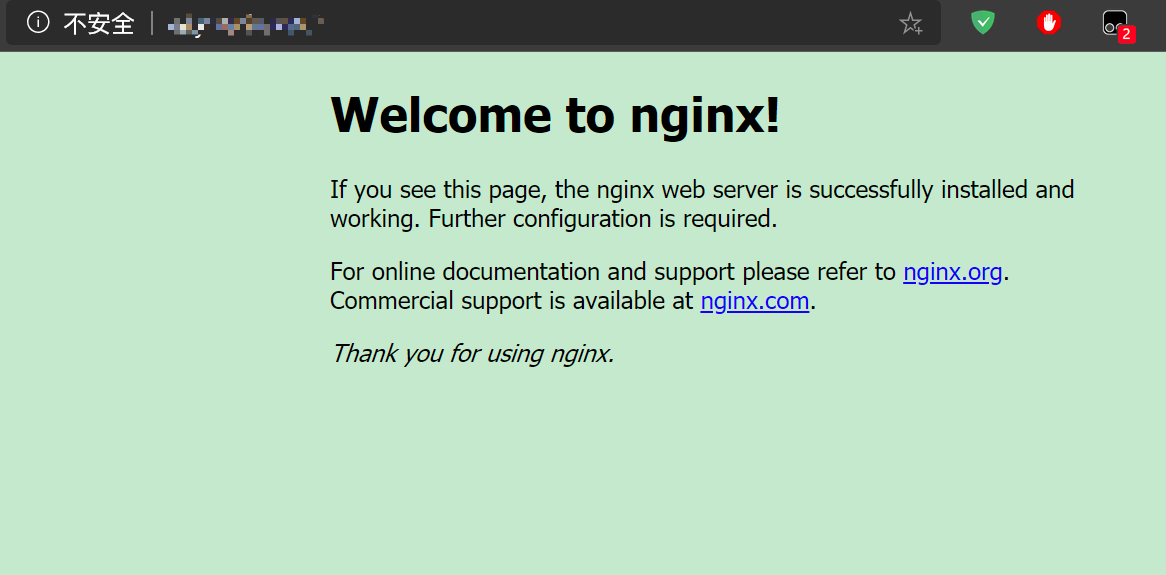Nginx教程 安装
创始人
2024-06-02 02:49:29
0次
1、Linux 安装
不管是使用的Windows虚拟机环境该是ubuntu操作系统,咱们都是基于Linux环境的安装。具体操作步骤如下。
1.1、更新Nginx安装包
// 更新包sudo apt-get update
// 下载安装nginxsudo apt-get install nginx1.2、Ubuntu安装之后的文件结构大致为
所有的配置文件都在/etc/nginx下,并且每个虚拟主机已经安排在了/etc/nginx/sites-available下
程序文件在/usr/sbin/nginx
日志放在了/var/log/nginx中
并已经在/etc/init.d/下创建了启动脚本nginx
默认的虚拟主机的目录设置在了/var/www/nginx-default (有的版本 默认的虚拟主机的目录设置在了/var/www, 请参考/etc/nginx/sites-available里的配置)
其实从上面的根目录文件夹可以知道,Linux系统的配置文件一般放在/etc,日志一般放在/var/log,运行的程序一般放在/usr/sbin或者/usr/bin。当然,如果要更清楚Nginx的配置项放在什么地方,可以打开/etc/nginx/nginx.conf 然后通过这种方式安装的,会自动创建服务,会自动在/etc/init.d/nginx新建服务脚本,然后就可以使用一下命令来启动。还有一个好处,创建好的文件由于放在/usr/sbin目录下,所以能直接在终端中使用nginx命令而无需指定路径。
sudo service nginx {start|stop|restart|reload|force-reload|status|configtest|rotate|upgrade}脚本如下:
#!/bin/sh### BEGIN INIT INFO
# Provides: nginx
# Required-Start: $local_fs $remote_fs $network $syslog $named
# Required-Stop: $local_fs $remote_fs $network $syslog $named
# Default-Start: 2 3 4 5
# Default-Stop: 0 1 6
# Short-Description: starts the nginx web server
# Description: starts nginx using start-stop-daemon
### END INIT INFOPATH=/usr/local/sbin:/usr/local/bin:/sbin:/bin:/usr/sbin:/usr/bin
DAEMON=/usr/sbin/nginx
NAME=nginx
DESC=nginx# Include nginx defaults if available
if [ -r /etc/default/nginx ]; then. /etc/default/nginx
fiSTOP_SCHEDULE="${STOP_SCHEDULE:-QUIT/5/TERM/5/KILL/5}"test -x $DAEMON || exit 0. /lib/init/vars.sh
. /lib/lsb/init-functions# Try to extract nginx pidfile
PID=$(cat /etc/nginx/nginx.conf | grep -Ev '^\s*#' | awk 'BEGIN { RS="[;{}]" } { if ($1 == "pid") print $2 }' | head -n1)
if [ -z "$PID" ]; thenPID=/run/nginx.pid
fiif [ -n "$ULIMIT" ]; then# Set ulimit if it is set in /etc/default/nginxulimit $ULIMIT
fistart_nginx() {# Start the daemon/service## Returns:# 0 if daemon has been started# 1 if daemon was already running# 2 if daemon could not be startedstart-stop-daemon --start --quiet --pidfile $PID --exec $DAEMON --test > /dev/null \|| return 1start-stop-daemon --start --quiet --pidfile $PID --exec $DAEMON -- \$DAEMON_OPTS 2>/dev/null \|| return 2
}test_config() {# Test the nginx configuration$DAEMON -t $DAEMON_OPTS >/dev/null 2>&1
}stop_nginx() {# Stops the daemon/service## Return# 0 if daemon has been stopped# 1 if daemon was already stopped# 2 if daemon could not be stopped# other if a failure occurredstart-stop-daemon --stop --quiet --retry=$STOP_SCHEDULE --pidfile $PID --name $NAMERETVAL="$?"sleep 1return "$RETVAL"
}reload_nginx() {# Function that sends a SIGHUP to the daemon/servicestart-stop-daemon --stop --signal HUP --quiet --pidfile $PID --name $NAMEreturn 0
}rotate_logs() {# Rotate log filesstart-stop-daemon --stop --signal USR1 --quiet --pidfile $PID --name $NAMEreturn 0
}upgrade_nginx() {# Online upgrade nginx executable# http://nginx.org/en/docs/control.html## Return# 0 if nginx has been successfully upgraded# 1 if nginx is not running# 2 if the pid files were not created on time# 3 if the old master could not be killedif start-stop-daemon --stop --signal USR2 --quiet --pidfile $PID --name $NAME; then# Wait for both old and new master to write their pid filewhile [ ! -s "${PID}.oldbin" ] || [ ! -s "${PID}" ]; docnt=`expr $cnt + 1`if [ $cnt -gt 10 ]; thenreturn 2fisleep 1done# Everything is ready, gracefully stop the old masterif start-stop-daemon --stop --signal QUIT --quiet --pidfile "${PID}.oldbin" --name $NAME; thenreturn 0elsereturn 3fielsereturn 1fi
}case "$1" instart)log_daemon_msg "Starting $DESC" "$NAME"start_nginxcase "$?" in0|1) log_end_msg 0 ;;2) log_end_msg 1 ;;esac;;stop)log_daemon_msg "Stopping $DESC" "$NAME"stop_nginxcase "$?" in0|1) log_end_msg 0 ;;2) log_end_msg 1 ;;esac;;restart)log_daemon_msg "Restarting $DESC" "$NAME"# Check configuration before stopping nginxif ! test_config; thenlog_end_msg 1 # Configuration errorexit $?fistop_nginxcase "$?" in0|1)start_nginxcase "$?" in0) log_end_msg 0 ;;1) log_end_msg 1 ;; # Old process is still running*) log_end_msg 1 ;; # Failed to startesac;;*)# Failed to stoplog_end_msg 1;;esac;;reload|force-reload)log_daemon_msg "Reloading $DESC configuration" "$NAME"# Check configuration before stopping nginx## This is not entirely correct since the on-disk nginx binary# may differ from the in-memory one, but that's not common.# We prefer to check the configuration and return an error# to the administrator.if ! test_config; thenlog_end_msg 1 # Configuration errorexit $?fireload_nginxlog_end_msg $?;;configtest|testconfig)log_daemon_msg "Testing $DESC configuration"test_configlog_end_msg $?;;status)status_of_proc -p $PID "$DAEMON" "$NAME" && exit 0 || exit $?;;upgrade)log_daemon_msg "Upgrading binary" "$NAME"upgrade_nginxlog_end_msg $?;;rotate)log_daemon_msg "Re-opening $DESC log files" "$NAME"rotate_logslog_end_msg $?;;*)echo "Usage: $NAME {start|stop|restart|reload|force-reload|status|configtest|rotate|upgrade}" >&2exit 3;;
esac1.3、测试安装是否成功
在命令行中输入:
sudo nginx -t窗口显示:
nginx: the configuration file /etc/nginx/nginx.conf syntax is ok
nginx: configuration file /etc/nginx/nginx.conf test is successful安装成功,则在浏览器输入IP地址,如下图即为安装成功:

1.4、卸载
1.4.1、停止nginx服务
sudo service nginx stop1.4.2、删除nginx,-purge包括配置文件
sudo apt-get --purge remove nginx1.4.3、移除全部不使用的软件包
sudo apt-get autoremove1.4.4、罗列出与nginx相关的软件并删除
dpkg --get-selections|grep nginx
sudo apt-get --purge remove nginx
sudo apt-get --purge remove nginx-common
sudo apt-get --purge remove nginx-core1.4.5、查看nginx正在运行的进程,如果有就kill掉
ps -ef |grep nginxsudo kill -9 XXX2、mac Docker安装
相比较于Linux安装,使用容器就比较快捷。在我的另一篇博客中我有详细描述使用docker安装Nginx,大家可以进行参考。传送门:https://blog.csdn.net/lly576403061/article/details/129419317?spm=1001.2014.3001.5502
相关内容
热门资讯
保存时出现了1个错误,导致这篇...
当保存文章时出现错误时,可以通过以下步骤解决问题:查看错误信息:查看错误提示信息可以帮助我们了解具体...
汇川伺服电机位置控制模式参数配...
1. 基本控制参数设置 1)设置位置控制模式 2)绝对值位置线性模...
不能访问光猫的的管理页面
光猫是现代家庭宽带网络的重要组成部分,它可以提供高速稳定的网络连接。但是,有时候我们会遇到不能访问光...
表格中数据未显示
当表格中的数据未显示时,可能是由于以下几个原因导致的:HTML代码问题:检查表格的HTML代码是否正...
本地主机上的图像未显示
问题描述:在本地主机上显示图像时,图像未能正常显示。解决方法:以下是一些可能的解决方法,具体取决于问...
不一致的条件格式
要解决不一致的条件格式问题,可以按照以下步骤进行:确定条件格式的规则:首先,需要明确条件格式的规则是...
表格列调整大小出现问题
问题描述:表格列调整大小出现问题,无法正常调整列宽。解决方法:检查表格的布局方式是否正确。确保表格使...
Android|无法访问或保存...
这个问题可能是由于权限设置不正确导致的。您需要在应用程序清单文件中添加以下代码来请求适当的权限:此外...
【NI Multisim 14...
目录 序言 一、工具栏 🍊1.“标准”工具栏 🍊 2.视图工具...
银河麒麟V10SP1高级服务器...
银河麒麟高级服务器操作系统简介: 银河麒麟高级服务器操作系统V10是针对企业级关键业务...